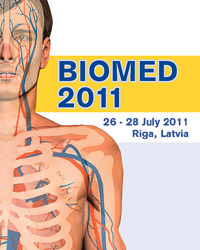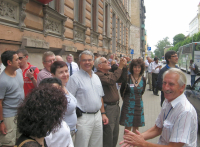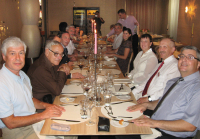BIOMED 2011
Ninth International Conference on Modelling in Medicine and Biology
26 - 28 July 2011
Riga, Latvia
Introduction
 The 9th International Conference on Modelling in Medicine and Biology has recently taken place in Riga, Latvia, organised by the Wessex Institute of Technology of the UK, in collaboration with Riga Technical University, Riga Stradins University and the Arabian Gulf University, Bahrain.
The 9th International Conference on Modelling in Medicine and Biology has recently taken place in Riga, Latvia, organised by the Wessex Institute of Technology of the UK, in collaboration with Riga Technical University, Riga Stradins University and the Arabian Gulf University, Bahrain.
The co-chairmen were Professor Roustem Miftahof from the Arabian Gulf University, Professor Ivar Knets from the Riga Technical University, Professor Maija Eglite from Riga Stradins University and Professor Carlos Brebbia from the Wessex Institute of Technology.
The conference papers dealt with the development of computational tools for the solution of medical and biological problems. The use of mathematical ideas, models and techniques is rapidly growing and is gaining prominence through the biosciences. The field of computational biology emerged from the need to integrate them. Applied mathematicians and bioengineers working alongside bioscientists provide a quantitative description to intricate processes at the subcellular, cellular and tissue levels and integrate them in “viable” models. Such models uphold gnostic properties, offer an invaluable insight into hidden and experimentally inaccessible mechanisms of organ function and allow the researcher to capture the essence of dynamic interactions within it.
Studies were presented on the solution of physiological processes and the very important case of the simulation of cardiovascular systems. One of the most successful areas of bioengineering has been biomechanics and orthopaedics, which are topics studied in several of the papers contained in the volume. The conference also covered the types of data acquisition and analysis.
Conference Sessions

The conference papers were grouped into the following sessions;
- Cardiovascular systems
- Biomechanics
- Simulation of physiological processes
- Orthopaedics and bone mechanics
- Data acquisition and analysis
Keynote Address by Professor Ivar Knets
The conference opened with a keynote address by Professor Ivar Knets on ‘Changes of the mechanical properties of bone tissue during ageing’.
His keynote address dealt with the important topic of how ageing affects the biological and mechanical behaviour of bone tissues. Professor Ivar Knets, the speaker, has until recently been the Rector of Riga Technical University and continues to be the Director of the Institute of Biomaterials and Biomechanics. His work is internationally renown and he has been Visiting Scholar at well-known centres such as Brown, Yale, Case Western Reserve and Stanford Universities. His research and many publications have contributed to making his Institute a world-renown Centre for biomechanics.
Professor Knets described the biological and mechanical factors affecting the biomechanical behaviour of bone tissue. Ageing produces in older persons musculosketal problems, which may often imply pain and reduced mobility. Nobody knows exactly what causes the human body to wind down and the scientific study of ageing is an expanding discipline.
It is suspected that at least half of the changes to bones and muscles are because they are simply not used often enough. Much of what was once considered part of the normal ageing process is in fact the result of different diseases and an unhealthy lifestyle. Muscle mass decreases 5-10% during every decade of increasingly sedentary adult life. Most of the age-related changes to joints are caused by lack of exercise.
Invited Presentations
Other invited presentations were;
‘Identification of landmarks on lower limb joint from CT images for kinematics studies: a totally semi-automatic procedure’
by Christina Bignardi, Politecnico di Torino, Italy
‘Thermal comfort in operating rooms: a case study’
by Francisco Patania, University of Catania, Italy
‘Choi-Williams time-frequency analysis of forearm flexors mecanomyogram acquired from a laser diode sensor based probe’
by Slimane Mekaoui, Université des Sciences et de la Technologie, Algeria
‘Multiscale comparison of air quality modeling for an ozone occurrence during the 1996 Paso Del Norte Ozone Campaign’
by Paul Tchounwou, Jackson State University, USA
‘Mathematical modelling of the pregnant human uterus’
by Roustem Miftahof, Arabian Gulf University, Bahrain
‘Indoor motion analysis of a subject wearing prosthesis for adaptive snowboarding’
by Laura Gastaldi, Politecnico di Torino, Italy
‘Modelling of stent expansion dynamics and resultant arterial wall and lesion stresses in a stenosed artery’
by Matthew Hyre, Northwestern University, USA
‘Correlation of morphological parameters with likelihood of thrombus formation in intracranial aneurysms’
by Kenjiro Shimano, Tokyo City University, Japan
‘Dominant EEG frequencies of patients undergoing dobutamine stress test’
by Alastair Macpherson, Lehigh University, USA
‘Numerical evaluation of the slope and intercept of end-systolic pressure-volume relation’
by Rachad Shoucri, Royal Military College of Canada, Canada
City Tour of Riga
 A short city tour took place during the first day of the conference to introduce the delegates to some the unique sites of Riga. The tour was on bus and foot, and conducted by an excellent guide who was very well versed in the history of the city as well as the many events that took place in the region of the Baltic since the Teutonic Knights’ conquest. The delegates and their partners were able to see the most significant sights of Riga – views of the City Canal parks, the Bastion Hill, the Powder Tower, the Freedom Monument, the Opera House and other theatres amongst others. They also walked along streets where most of Riga’s Germanic Art Nouveau buildings are located. These buildings are the best examples of their type in the world. The walk took the participants along the streets of the old Hanseatic city, strolling along the cobblestones to see the Dome Cathedral, the church of St Peter, the old Guild Houses, the Swedish Gate and many other museums and historical buildings.
A short city tour took place during the first day of the conference to introduce the delegates to some the unique sites of Riga. The tour was on bus and foot, and conducted by an excellent guide who was very well versed in the history of the city as well as the many events that took place in the region of the Baltic since the Teutonic Knights’ conquest. The delegates and their partners were able to see the most significant sights of Riga – views of the City Canal parks, the Bastion Hill, the Powder Tower, the Freedom Monument, the Opera House and other theatres amongst others. They also walked along streets where most of Riga’s Germanic Art Nouveau buildings are located. These buildings are the best examples of their type in the world. The walk took the participants along the streets of the old Hanseatic city, strolling along the cobblestones to see the Dome Cathedral, the church of St Peter, the old Guild Houses, the Swedish Gate and many other museums and historical buildings.
The excursion provided the delegates with an occasion of further strengthening their contacts in a relaxed atmosphere.
Conference Banquet
 The conference banquet took place in arguably the best restaurant in town, whose catering is in demand for official functions and other public occasions. The menu consisted of a fresh fish appetizer followed by lamb and ending with a selection of home-made desserts. The menu was accompanied by excellent Chilean Sauvignon and Argentine Malbec wines. The atmosphere of the banquet, which took place in a private room was most convivial and friendly.
The conference banquet took place in arguably the best restaurant in town, whose catering is in demand for official functions and other public occasions. The menu consisted of a fresh fish appetizer followed by lamb and ending with a selection of home-made desserts. The menu was accompanied by excellent Chilean Sauvignon and Argentine Malbec wines. The atmosphere of the banquet, which took place in a private room was most convivial and friendly.
During the second night the delegates were invited to an informal dinner to discuss topics of common interest and proposals for the next meeting.
Panel Discussion on Environmental Changes in Health
The conference included a Panel discussion on Environmental Changes in Health, chaired by Professor Roustem Miftahof and moderated by Professor Carlos Brebbia. The panel comprised Professor Alistair Macpherson of Lehigh University, Professor Matthew Hyre of Northwestern University, USA and Professor Eric Suuberg of Brown University, USA.
The panel discussed some interesting problems affecting human health today, including the lack of exercise and sedentary ways of life. Prevention plays a major role as well as the amount of contaminants that are safe. They discussed how accurate are the tests carried out on animals to decide toxicological effects. Many medications are not sufficiently safe from the point of view of long-term effects and their whole range of applications. The general distribution of research funds could be open to question as this system will not support ideas that are totally original being based on the peer review system. Too many vested interests, commercial and scientific, are stopping invention.
The current system for screening chemicals is not sufficient for the multitude and diversity of new products coming into the market. The point was made that pollution is directly related to consumption and what we are now doing is exporting the pollution to developing parts of the world.
A major environmental problem is stress, followed by the air we breathe and the water we drink, all man-made pollution factors. The final major factor is the food we eat which becomes part of our body. These are the major negative factors for Human Environmental Health.
The problem is how to consolidate them with our wish to have an improved standard of life and longevity. It is important to ask ourselves what effects our current development will have in the future, with problems such as genetically modified food. We still do not fully understand the effects of widely prescribed drugs, many of which have very limited benefits.
The panel also commented on the effect of antibiotics and the resistance we are building to them. It is difficult to resolve this problem due to their widespread use and abuse. They are giving rise to allergies and allergic reactions.
Publication of Proceedings
The proceedings of Environmental Health and Biomedicine, 512pp (Print ISBN: 978-1-84564-524-3; Online ISSN: 1743-3525) are available in paper and digital format from WIT Press priced at £220/US$440/€308. Orders can be placed on the WIT Press web site at www.witpress.com or by email:
Papers from the conference will also be hosted online at the WIT eLibrary as Volume 15 of WIT Transactions on Biomedicine and Health (Online ISSN: 1743-3525). For more details visit the WIT eLibrary at http://library.witpress.com

 Wessex Institute
Wessex Institute